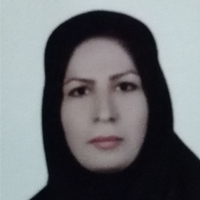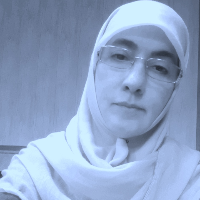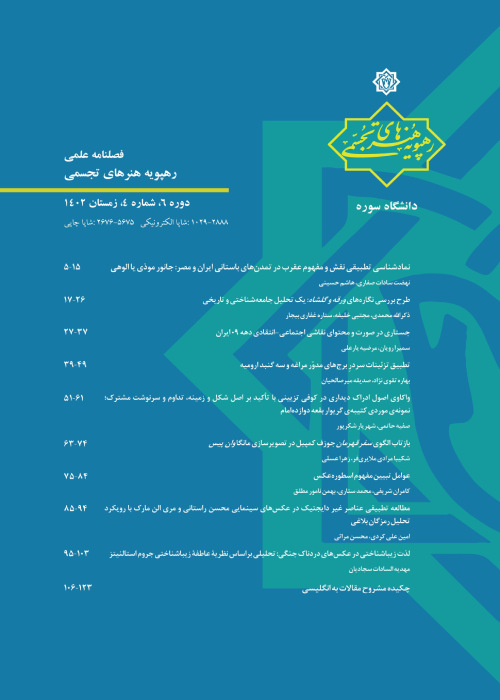Important Features of Khamsah Manuscript Illuminations(No. Add ms 25900) Preserved in the British Library
Author(s):
Article Type:
Research/Original Article (دارای رتبه معتبر)
Abstract:
From the earliest centuries in Islamic civilization, illumination was used in manuscripts because it was used in conjunction with calligraphy. So Muslim artists have paid attention to it. One of the exquisite and artistic copies produced in the middle of the ninth century AH (846 AH), during the Timurid period in Harat, is the Nezami’s khamsah (Add ms 25900), which is preserved in the British Museum. This manuscript has been studied many times by researchers due to its excellent illustrations. Some of them are attributed to Behzad. This manuscript has 316 folios and its Dimensions is (leaf): 19.1 × 12.1 cm. This manuscript has been written by nastaʿlīq script and it has 19 miniatures and 5 Illuminations.Although this manuscript has a lot of great illuminations. But unfortunately the illuminations of this manuscript have not been specifically analyzed up to now. Therefore, the aim of the authors in this article is to show the approach of the artist or artists in designing the illuminations in this manuscript by showing the amount of diversity used in the structure of illuminations (390 inter-text panels) in this manuscript. As a result, these questions were raised to achieve this goal. 1- Considering that there are many decorated panels in this manuscript, how much variety is used in these panels? 2- Is the date of design of the illuminations coincides with the date of writing the manuscript (Timurid period ninth-century AH)? 3- How can small intertextual panels in this manuscript (390 panels) be classified? This article has been done by descriptive and analytical method, and the necessary information has been obtained from library sources and study of manuscript illuminations.This manuscript has four full decorated pages at the beginning of the manuscript. At first glance, they look similar, but studies have shown that they are different in detail. This manuscript has five Title pages, four of which were decorated in the Timurid period and one of them (Sharaf nameh section) was decorated in the Safavid period. The decoration of each of them is different from the other. In addition, this manuscript has 390 panels in the text. The first study was done on the size of these panels. The length of all these panels is equal to two of the four columns of the text, but in contrast, their width is different. 50 inscriptions (panels) were randomly selected from the beginning to the end of the manuscript and the ratio of their length to width was determined. The length of the inscriptions was a fixed number A and the width of the inscriptions was a variable number B and the ratio of a to b in each inscription was considered to be N. The numbers obtained for N were divided into three groups: Inscriptions whose n is less than 3: wide, Inscriptions whose N is between 3 and 3.99: Normal, and Inscriptions whose N is more than 4: Narrow. Results of the study: 7 inscriptions less than 3 (wide inscriptions), 12 inscriptions more than 4 (narrow inscriptions) and 31 inscriptions between 3 to 3.99 (ordinary inscriptions). So the percentage of inscriptions will be equal to: wide 14%, narrow with 24% and ordinary inscriptions 62%. Studies have shown that the width of the inscriptions varies, although a large group of these inscriptions (62% of them) are about the same size. In the second part of this study, the panels were classified according to their structure, Patterns, and colors. For example, 22 inscriptions without medallions: 21 inscriptions of Arabesque ornaments only, 1 inscription of Khatai ornaments only. 368 inscriptions with medallions: 64 incomplete inscriptions. 304 complete inscriptions: 164 inscriptions with Arabesque theme only. 131 inscriptions with Arabesque and Khatai background design and 9 inscriptions with Khatai and ... Studies and comparisons showed that the decoration of each panel is different from the other. It is necessary to mention that panels in the Sharaf nameh section remain incomplete and they also belong to the Safavid period. It was also found that Arabesque ornaments were used much more than foliage (Khatai) ornaments in illuminations, and ultramarine color uses more than golden color.Prior to this research, some researchers had noted the diversity in the design of frontispiece. But it is important to observe this amount of variation in the small textual inscriptions in this manuscript. It is very important to see the great variety in the panels of this manuscript. Because the illuminator or illuminators, due to the large number of panels and manuscript papers, could easily execute many panels like each other without the audience noticing the similarity. Therefore, this attempt to create different frames and panels in this manuscript can be considered as originating from the thought and worldview of the decorator or the decorators of this manuscript. By studying other examples, it is possible to attribute this kind of attitude to other illuminator or illuminators in Islamic civilization.
Keywords:
Language:
Persian
Published:
Journal of Rahpooye honar, Volume:5 Issue: 2, 2022
Pages:
81 to 96
https://magiran.com/p2476514
سامانه نویسندگان
مقالات دیگری از این نویسنده (گان)
-
" Recognizing the art of Ruling (Jadval( since the 9th century; Based on texts, documents and manuscripts"
ELHAM AKBARI *, , Maryam Keshmiri
Journal of Negarineh Islamic Art, -
Representation of Cultural Identity of Women and Girls in the Cover Designs of Children's Stories in Arab Countries
Ghufran Brimo, *
Journal of WOman in Culture Arts, -
Visual anthropology in globalization path(Case study: contemporary Iranian posters)
Farimah Fatemi, Efatolsadat Afzaltusi *
Journal of Cultural Studies Communication, -
The Stylistics of Golden Rulings (Jadwal) in Timurid and Safavid Manuscripts (Ninth to Twelfth Centuries AH)
, *, Maryam Keshmiri
Negareh journal,




